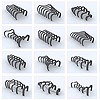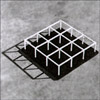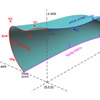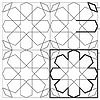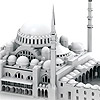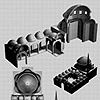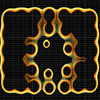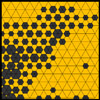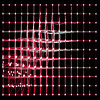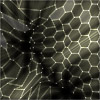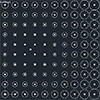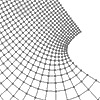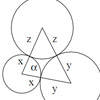In 2007, we conducted a computational design studio in YTU / CADU with Birgül Çolakoğlu. Below is the brief of the paper published at METU JFA Vol24 issue 2 titled “An Innovative Design Education Approach: Computational Design Teaching For Architecture”. We were dealing with how new technologies are affecting the design cycle. Rhinoscript is used as an educational tool, and various short exercises are conducted with it. After 6 years, […]
Posts categorized under Practice
Architectural education in its relation to computational technologies is both becoming a part of these studies and having the potential of renovating itself with the knowledge of emerging technologies. This paper, in this framework, will be presenting a design research studio that aims at developing relational thinking capabilities in the computational design process. In this studio, topics of parametric design, parametric modeling, and relationality were questioned through the design process. […]
This simple tool, N-Grid resembles John Hejduk and colleagues’ famous design exercise “The Nine-Square Grid”. I developed the tool in 2009 using MaxScript. The nine-square grid is one of the most common kit-of-parts exercises in design studios for over 50 years. To explain briefly, the nine-square grid exercise is based on transforming a nine-square grid into a series of alternatives. The nine-square grid is an open-ended educational application with a limited but flexible context. It […]
From the 2009 eCAADe paper presented with Birgül Çolakoğlu titled; “Designer as Casual Coder: Overview of an Experimental Design Studio”; In recent years, computational approaches in architecture started to change the scope of the architect’s work. He/she is not any more a passive tool user instead, became a casual tool developer. Conventional CAD systems that focus on geometric representation of a designed artifact, are transforming into systems in which the […]
It was the 2008, eCAADe Presentation at Antwerp together with Birgül Çolakoğlu and Serkan Uysal. This paper presents a student work developed in the Introduction to Computational Design graduate course titled “Designing the Design” at Yildiz Technical University. The course focuses on the use of algorithms as design tools, rather than coding experiments. The course runs parallel to the shape grammar course. There, we study the basic concepts of computation […]
Studio exercises are short-term and open-ended design activities that represent a constructivist learning approach by limiting design domains. They are student-centered, model and process-oriented educational tools. These qualities make studio exercises potential tools for integrating contemporary Digital Design thinking into architectural education. This research aims to reveal these potentials by defining an analytical perspective and logical connections between the pedagogical intentions of studio exercises and the theory of Digital Design. […]
Throne of my lonely niche, my wealth, my love, my moonlight.My most sincere friend, my confidant, my very existence, my Sultan, my one and only love.The most beautiful among the beautiful …My springtime, my merry-faced love, my daytime, my sweetheart, laughing leaf …My plants, my sweet, my rose, the one only who does not distress me in this room …My Istanbul, my karaman, the earth of my AnatoliaMy Badakhshan, my […]
Under the dust of 10 years; revisiting my master’s thesis; This paper introduces research about the Computer Aided Instruction (CAI) tool which is based on the master thesis of Tuğrul Yazar from Yıldız Technical University (YTU) Faculty of Architecture Computational Design Graduate Program (BOM). The thesis is named “Expert Systems for Architectural Education: The Expert System of Sinan Mosques” and was completed in 2003 under the supervision of Dr. Birgül […]
This is the third and the last project of the Infections workshop conducted at YTU this week. The conceptual Framework is developed by Betül Dönmez (DEU). In this project, the host body is infected by high fever and pressure and changes its solid phase into plasma. The solid molecules of the existing body transform to become plasmatic. This substance can react to various movements around it. When someone comes close to the […]
This is another final project of the three-day workshop at YTU, named Infections. A conceptual framework is developed by Bahar Aybudak (METU) and Zeynep Gür (ITU). The cellular forms come together to set the existing wall (host body). The wall represents the body structure, in which in case of any infection, various challenges could be seen in parallel with the immune system. The struggle with the mentioned infection is observed through […]
This is one of the three final projects of the Infections workshop at YTU. The conceptual framework is developed by Begüm Aktaş (YTU) and Merve Özhan (BAU). According to them; the existing host body is a 16×11 unit glass brick wall, which is constructed to separate the corridor of the faculty and to create semi-private spaces for various activities. In this project, the host body is considered the dead tissue […]
The series of workshops named “gridal infection”, or “infections” in short, explore the multiplicity of pattern deformation in a pedagogical context. It aims to encourage design students to manage an associative process of design, composed of short-term constructive assignments. Students are expected to develop an understanding of contemporary computational design techniques regarding a connection between abstraction and conceptualization. It reflects an open discussion of the abstract types and methods of potential […]
This started as a pragmatist search of the term “Objectile”. I was curious about the real meaning of it, while the famous 1995 works of Bernard Cache were the thing I was looking for as images. I found two things about this word. One of them is the reproductions and online marketing of those famous carved panels (I was searching for), and while the second thing was a very interesting […]
Here is an interesting phrase from Jill Larkin and Herbert Simon’s famous article. It is “Why A Diagram (Sometimes) Worth Ten Thousand Words”; The phrase from the article We consider external problem representations of two kinds. Both of which use a set of symbolic expressions to define the problem. The fundamental difference between our diagrammatic and sentinential representations is that the diagrammatic representation preserves explicitly the information about the topological […]
This is my first try at DesignScript syntax. It is quite easy to understand and on-screen reference help seems to work well. It creates regular AutoCAD entities when you run. One of the most important concepts of this language is said to be a kind of associativity that updates objects when any parameter is changed while the script is running. However such associativity is not possible after the script has […]
Nowadays I plan to enter Rhinoscript, Python, and DesignScript back again. However, I can’t leave Grasshopper3D without mentioning the “cognitive shift” it pioneered in the design computing community. Here is a phrase from a famous special issue of “Computer” Journal, published in 1982 with Tilak Agerwala and Arvind’s editorials; Data flow languages form a subclass of the languages which are based primarily upon function application (i.e., applicative languages). By data […]
In 1982, it has been more than 15 years since the dataflow approach to algorithm designing are discussed in computer science. Computer journal publishes a special issue with the foreword of Tilak Agerwala; he says; …We have discussed two characteristics of the von Neumann model of computation: global updatable memory and a single program counter. It will become clear shortly that the data flow model has neither of these. First, the data flow model […]
Studying circle packing led me back to my high school days. First, I’ve tried to write a vb.net component so that I would say Grasshopper to place circles and check lots of things iterating again and again. Then I felt that this was not my real interest in circle packing. After finding an old post by Daniel Piker (here), I’m truly enlightened about an old topic of our high school […]
When I was younger, among the branches of philosophy, I had studied a little logic and, among the subjects of mathematics, geometrical analysis and algebra, three arts or sciences which looked as if they ought to contribute something to my project. But in looking at them, I took care, because, so far as logic is concerned, its syllogisms and most of its other instructions serve to explain to others what […]
Since last week, I’m very curious about circle packing. There are a couple of complete solutions on the internet. I’m still in the early steps of such a solution yet. A full circle packing means that it does not include any gaps and each circle is tangent to all possible neighbors. Sounds easy in Grasshopper but I couldn’t see any solution yet. There are some circle-packing attempts but they have […]


